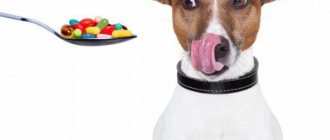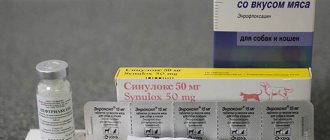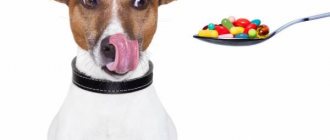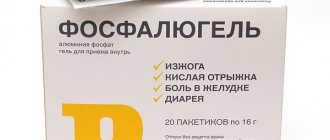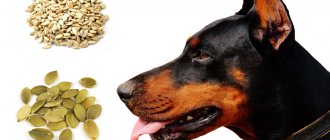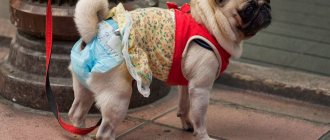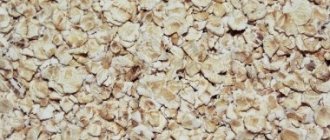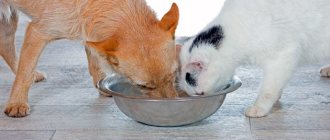Digestive disorders in dogs are “an everyday matter.” Diarrhea is often explained by the fact that the pet ate something “wrong.” Dogs that are kept in “semi-free” conditions and constantly have the opportunity to rummage through garbage have a very “hardened” digestive system, and therefore such troubles happen to them less often. If a more “domestic” dog “snacks” on garbage, diarrhea also occurs sporadically and does not cause any special problems. But the owner must be wary and immediately take his pet to the clinic if the dog has water diarrhea.
What is diarrhea
Diarrhea is a condition where a dog defecates frequently. Most often, diarrhea in dogs begins as a result of inflammation of the small intestine and is caused by various pathological agents.
Diarrhea in dogs is quite common. The pathological condition can occur regularly and end quickly. However, there are situations when acute diarrhea continues for several weeks in an individual. If the disease appears once without sudden recurrences or any consequences, you don’t have to worry about your pet’s condition. However, if your pet begins to have prolonged diarrhea with all the symptoms, such as frequent bowel movements with a large content of liquid, the appearance of mucus and blood in the stool, as well as lethargy and drowsiness, you need to visit a veterinarian.
When choosing a treatment method, be sure to pay attention to the color of the stool. Therapy is usually carried out at home and mandatory points include changing the feeding regimen and increasing the amount of fluid consumed. When diarrhea occurs, a pet loses a significant amount of moisture and nutrients, and drinking helps prevent dehydration and also restore the balance of electrolytes in the body. Among the medications used to combat diarrhea, adsorbents are used. In some cases, antibacterial and antiviral agents are used.
Causes
If the feces become wet and have a foul odor, this may indicate an upset stomach in your dog.
Veterinarians distinguish 2 main forms of diarrhea:
- Acute lasts up to 21 days and is characterized by stools with a large content of water. Blood may be present in the excrement. Diarrhea is especially dangerous in the summer, as it leads to rapid dehydration.
- The chronic form lasts more than 21 days. The symptoms remain the same, but changes in behavior appear. The animal may refuse food, activity decreases and weight drops significantly. Some small dogs, such as Chihuahuas, may have problems due to the increased amount of fiber in the food.
Why do dogs get diarrhea?
- Improper feeding;
- A sharp change in diet;
- Allergies to a certain type of food or smell in the house;
- Vitamin deficiencies;
- Acute food poisoning;
- Intoxication of various etiologies;
- Viral, bacterial infections;
- Parasitic infestations;
- Congenital malformations of the gastrointestinal tract (GIT);
- Inflammatory reactions;
- Oncological diseases (especially polyps);
- Piroplasmosis;
- Age-related disorders.
Diarrhea may occur after the use of antibiotics that affect the microflora of the stomach and intestines, or during postoperative rehabilitation. Typically, such conditions do not cause significant harm to the pet. However, against a background of weakness, prolonged diarrhea can lead to a crisis and subsequently death.
Diagnosis of diarrhea
Disorder in a dog can begin abruptly and disappear just as abruptly. However, there are cases when it is necessary to carry out a differential diagnosis of diarrhea. To do this you will need to take a test. The main ones include:
- Full clinical examination. The mucous membranes of the oral cavity, the condition and behavior of the dog are studied.
- Stool analysis (microscopic examination). Required for accurate differentiation of endoparasites that lead to the development of diarrhea.
- General blood analysis. The number of white blood cells is studied to assess the degree of inflammation or a decrease in the number of red blood cells in the blood. In addition, it is possible to detect dehydration of the body.
- A biochemical blood test is required to evaluate the functioning of internal organs, especially the kidneys, liver and pancreas.
- Urine analysis for the content of nonspecific proteins.
- X-ray examination of the abdominal cavity. Such an examination will accurately determine the location of all organs and the presence of foreign bodies or fluid in the gastrointestinal tract.
- Polymerase chain reaction for the presence of pathogenic agents. This test is required to diagnose parasitic diseases.
Depending on the clinical picture and symptoms, additional diagnostic tests may be prescribed. They will be selected depending on the condition of the animal and previous tests:
- Bacterial culture is required to determine the degree of sensitivity of the animal to medications, in particular to antibiotics.
- A cytological examination will help clarify the type of inflammatory reaction and accurately identify parasites and protozoa.
- Analysis for the presence of infectious agents.
- An ultrasound examination of the abdominal cavity is required if all previous tests have not given an accurate result.
- X-ray examination with contrast is necessary to accurately determine the presence of intestinal ulcer.
- An examination with an endoscope will accurately identify the condition of the animal’s intestines or stomach.
- A toxin test is rarely used, but will help determine exactly why the diarrhea started.
Use of Enterosgel
And finally, let’s talk about one more adsorbent. This is Enterosgel. According to the principle of its action, the medicine is both similar to activated carbon and Smecta. It gently envelops the intestinal mucous membranes, preventing their further irritation and the development of inflammatory processes. The medicine has decent absorption capacity, and therefore is able to absorb large volumes of toxic compounds . In addition, it can be given even to very young puppies.
The dose is not too large - two to three tablespoons of the drug per day per adult animal. For puppies, the dosage is halved. The medicine is given for four to five days until the clinical manifestations of the pathology completely disappear.
Associated symptoms
The causes of diarrhea can often be clarified after studying the accompanying signs that indicate the etiology of the disease. All four-legged owners may benefit from information about symptoms that indicate digestive disorders, including those that are life-threatening. There may be various accompanying symptoms of diarrhea in dogs.
A soft chair
If there is no blood or mucus in the stool, most likely the cause of the disease is the animal’s improperly structured diet, overeating or feeding food that is unusual for a dog, for example, from a human table. Also, with an increased content of fat in food, disturbances in the functioning of the gastrointestinal tract, including diarrhea, are possible.
If the stool does not become hard over a long period of time, you need to visit a doctor to carry out diagnostic measures. This is required to rule out giardiasis in a dog.
Diarrhea with blood
The presence of blood in a dog's stool is a clear sign of open bleeding in the gastrointestinal tract or anus.
The main reasons for the phenomenon include:
- Damage to mucous membranes due to consumption of roughage or inedible objects.
- The appearance of a severe neoplasm or intestinal ulcer.
This phenomenon is a reason to contact a veterinarian.
Diarrhea with mucus
The appearance of mucus in diarrhea is a dangerous pathological condition associated with the development of parvovirus or parasitic disease. Treatment can begin after determining the causes of the disease. Severe forms of the condition may require outpatient treatment at a veterinary hospital.
Colored diarrhea
Changes in the color of stool can occur for various reasons. The stool may become green, pink, gray, or bloody.
Causes of black stool:
- Prolonged bleeding in the digestive organs, which has become chronic.
- Malignant neoplasms.
- Changing your diet. Transferring the dog to wet or natural food.
If the stool turns yellow, the dog is likely eating a lot of fatty food. In this case, it is advisable to remove various dishes from the diet that contain a lot of fat. If such feces persist for more than a week, the cause may be an inflammatory process of the pancreas.
Diarrhea with water
The condition can be life-threatening if observed in sick, old dogs and puppies. The main reason for the danger is the high risk of dehydration.
Frequent relapses of diarrhea with water are a consequence of helminth infestation or the development of parvovirus infection. This condition necessarily requires consultation with a veterinarian followed by medical care.
Diarrhea and vomiting
This is one of the most dangerous combinations of symptoms and may indicate acute food poisoning, infectious diseases, or an increase in the rate of protozoan reproduction. In addition, with vomit, a significant amount of moisture leaves the dog’s body. Therefore, if your dog has diarrhea with vomiting, be sure to consult a veterinarian for advice.
If vomiting additionally appears, the situation becomes threatening. Through the oral cavity, a large volume of water and the remains of undigested food leave the body from the gastrointestinal tract.
If the urge to vomit occurs once and goes away quickly, there are usually no problems. However, if vomiting occurs regularly, the animal has a fever and is depressed, has a sluggish appetite, or completely refuses food, be sure to visit a veterinarian. This phenomenon may be a sign of various serious diseases, acute food poisoning. It is especially dangerous if the vomit contains a lot of foam and particles of blood or mucus. This may be a sign of a perforation of the intestine by a foreign body.
Possible reasons:
- The pet overate a lot.
- The dog was fed low-quality or stale food.
- The food contains a lot of fat or is difficult to digest.
- A drastic change in your pet's diet.
- An inedible object, a small piece of tissue, a small particle of metal or a fragment of material has entered the gastrointestinal tract.
- If the dog has been breathing chemicals or harmful substances for a long time.
- Severe form of bloating, accompanied by shortness of breath, hypersalivation, and hardening of the abdomen.
- Helminthiasis. Infection can occur at any age. In this case, a sharp decrease in mass is observed.
Dangerous diseases that can cause diarrhea and vomiting in dogs include:
- Parvovirus enteritis, also called canine distemper. The disease affects puppies aged 2–6 months. In this case, nasal and ocular mucous discharge appears. Erosion of the intestinal mucosa appears. The dog will be in a weakened state for about a week. Then arrhythmia and a decrease in body temperature are observed. Then, the exhausted animal dies.
- Rotavirus and coronaviruses have similar symptoms. The affected group includes dogs of all ages. Especially often in fragile puppies.
- Adenoviruses also infect dogs at any age, both young and adult. Characterized by eye inflammation.
With blood and mucus
If the dog went to the toilet with blood and mucus, you need to show the animal to the veterinarian, where further examination will be carried out, and a consultation on therapy will be carried out.
In case of mechanical damage to organs and open bleeding, it is possible to prescribe surgical intervention and subsequent hospitalization of the animal.
What and how can cause distress in an animal:
- Perforation of the intestinal walls.
- Inflammation of the pancreas.
- Ulcer.
- Disturbance of the intestinal microflora.
- Helminthiasis.
- Rabies in atypical form. In this case, enteritis occurs with hemorrhages in the intestines.
- Poisoning by toxins or medications.
- A large amount of blood in the excrement, without feces, may indicate the presence of bleeding in the intestines.
- Intestinal infections that lead to ulcers in the gastrointestinal tract.
- Neoplasms, especially polyps.
- Inflammatory processes in the intestines, which lead to the formation of ulcers and erosions.
- Leptospirosis, in which parasites live in the organs of the excretory system and lead to vascular damage.
Unusual colored diarrhea
If the dog's feces have changed color, this is often a consequence of vegetables eaten in advance. Otherwise, you need to worry about the condition of the animal.
If your dog has black diarrhea, there may be internal bleeding in the intestines.
Yellow diarrhea may appear for the following reasons:
- Indigestion.
- Liver problems.
- Worms.
- Jaundice.
- Plague.
White or gray diarrhea indicates a lack of bile in the excrement. This is a consequence of blockage of the bile ducts.
Red diarrhea is most often caused by blood in the stool. This is a consequence of damage to the colon or severe inflammation.
Green diarrhea is most often caused by putrefactive phenomena in the intestines or stomach.
Diarrhea without other symptoms
If diarrhea begins without complications, the causes are most often poor-quality or improperly selected nutrition, overeating, or problems with the dog’s gastrointestinal tract. How to treat such diarrhea in a dog: For treatment, you can give it various tablets and sorbents.
Feces with parasitic worms and worm eggs
If worms begin to multiply, helminth larvae and many small individuals will appear in the feces. In the case of prolonged helminth infestation, it is possible to count the number of worms in the digestive organs of the animal.
Main cause of the problem:
- The deworming procedure has not been carried out for a long time.
- Treatment for ectoparasites is rarely carried out.
- Uncontrolled diet of the animal, walking without a muzzle, the animal can eat various garbage on the street.
- Feeding low-quality meat and fish that have not undergone heat treatment.
A muzzle will prevent your dog from eating food from the ground outside.
What medications are suitable to relieve diarrhea?
What to give your dog for diarrhea? Human medications are also suitable for dogs. However, before dispensing the tablets, it is advisable to visit a veterinarian.
- Activated carbon is a traditional remedy. Helps with short-term diarrhea. It is necessary to take into account the weight of the animal.
- Smecta - helps with diarrhea without complications. Helps remove toxins from the body. The drug is taken orally, diluted from a syringe.
- Enterofuril is a suspension that helps in case of acute intestinal infections. Use only after consulting a veterinarian.
- Furazolidone – if your dog’s diarrhea was caused by an intestinal disorder, you can use this remedy in combination with other medications.
- Loperamide is a popular anti-diarrhea drug. Can be given once, one tablet.
- Levomycetin is a synthetic antibiotic effective against microbes. For animals, chloramphenicol 250 is given.
Tips for loose stools in dogs
If the stool is loose but has shape, there is no need to worry as it is actually a normal consistency. If their stool is soft and shapeless, that is, it is quite liquid, you should contact your veterinarian for an examination and to rule out possible serious pathologies.
It is absolutely normal for the last part of your dog's stool to be soft and even without consistency. This is because it is the last thing to enter the intestines, and all its moisture has not been absorbed. This is not a cause for concern.
If your dog rarely poops at general levels, this is due to the fact that he is eating outside of his usual diet, but may feel more or less fine. This is not a reason to worry, but to be attentive and make sure that the symptoms do not worsen.
Treatment of indigestion
How to stop diarrhea in a dog:
- If there are no signs of disease, it is enough to leave the animal on a starvation diet for 12 hours. However, it is necessary to provide the dog with plenty of fluids.
- If the diarrhea is over, you need to give a little rice broth or lean meat. It is best to feed turkey meat.
- During recovery, food portions should be kept small. It is advisable to feed the volume of food for several meals.
- It is advisable to give probiotics in addition to medications for diarrhea.
- Leave the animal on the diet for 3 days. If it does not give results, consult your veterinarian.
Medicines
When treating brown diarrhea in a dog, the veterinarian will select a set of medications depending on the etiology of the disease. It is especially important to stop water loss and eliminate the cause of the disease.
During treatment use:
- Sorbents for absorbing toxins.
- Remedies against worms.
- Antiviral drugs.
- Antibiotics.
- In case of severe depletion of the IV.
- Anti-neoplastic agents.
- Preparations for restoring microflora.
Moreover, before visiting a doctor, it is undesirable to give the dog medications so as not to blur the picture of the disease. You can only give activated charcoal if you are sure that the dog has been poisoned. For 1 kg of live weight it is required to give ½ tablet.
Nutrition correction
How to treat foul-smelling diarrhea in a dog:
- Leave the animal on a starvation diet until the diarrhea stops.
- Reduce portion sizes.
- Give only light food, no bones for diarrhea.
- Changing the diet to a dietary one, after consulting a veterinarian.
- Reducing the amount of fat in food.
- Whenever possible, feed animals exclusively holistic food.
- Adding vitamins to feed.
- Normalization of the amount of protein and carbohydrates in the feed.
Folk remedies
How to treat the disorder with folk remedies? For treatment, it is possible to give the dog rice water. The use of other means can worsen the diagnostic picture. In addition, most types of diarrhea cannot be cured only with folk remedies, without the use of medications.
Prevention
Diarrhea can begin even in healthy animals. However, to prevent dark brown or green diarrhea, you must follow these recommendations:
- Feed the animal only with specially designed food.
- Avoid overeating.
- Prohibit the animal from picking up leftovers on the street.
- Carry out deworming in a timely manner.
- Regularly allow your animal to play with various hard objects and bones.
Feeding a dog with diarrhea
If you have diarrhea, the first thing you need to do is not allow your dog to eat for the first few days. It is important to give plenty of water. As soon as the fast is over, you can give rice water or herbal tinctures.
After a day, it is allowed to give the dog fermented milk products. You can add cottage cheese. After which it is allowed to supplement the diet with boiled eggs and poultry meat. And no fried food.
Diarrhea in dogs is a pathological condition associated with digestive disorders, damage to the intestinal mucosa or infections. How to treat liquid diarrhea? For treatment I use sorbents, antiviral drugs, anti-inflammatory drugs. In some cases, surgery may be required.
Is loose stool bad?
Not at all , your dog's stool should actually be soft in texture. However, most dog food manufacturers add binders to their products. Which make dog stool hard.
Why do they do this? Because there is a flawed urban legend that makes us think that if our dog has loose stool, it's because the food isn't right for him . This is absolutely not true.
© shutterstock
If our dog has diarrhea, something is obviously wrong. But loose stools are not a red flag for solving nutrition problems. On the contrary, stool that is too hard can cause health problems for your dog.

